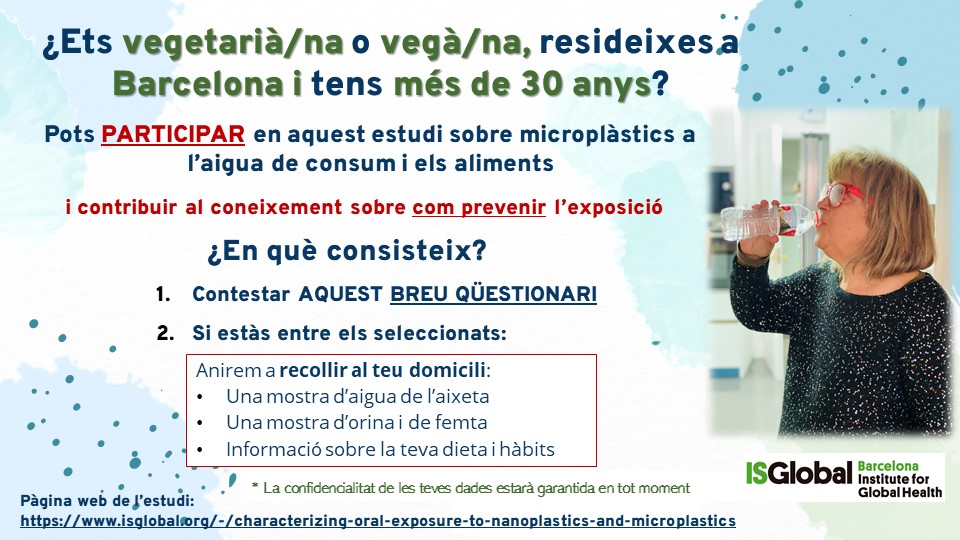Since plastic was invented around 1860, the use of this material has accompanied us in our daily lives: in sports shoes, pieces of clothing, toys, packaging, technology, etc. And although society is increasingly aware that we should minimize its use, we are still far from understanding the harmful effects that this material can have on our health and that of the planet.
The Barcelona Institute for Global Health (ISGlobal) is currently participating in the Characterizing Oral Exposure to Nanoplastics and Microplastics project, which seeks to find scientific evidence of the risk to human health from exposure to micro and nanoplastics. We talk to Carolina Donat, postdoctoral researcher on the project, to find out what the problem is and what they are studying.
First things first. What are microplastics and nanoplastics?
Micro and nanoplastics (MNP) are microscopic forms (measuring less than 5 mm) of plastic products. They can be manufactured intentionally, in the form of micro/nanoparticles, for example, for use in the cosmetic sector in exfoliating creams or toothpastes. Or they can be generated by the fragmentation of larger plastic products by the action of different physical, chemical or biological agents, the rolling and wear of tires or washing machines, among others. These materials also encompass a wide range of sizes (from 0.001 µm to 5,000 µm) and shapes (fragments, pellets, beads, fibers, foam, films…), and can be composed of different types of materials.
What impact can micro- and nanoplastics have?
MNP are known to be very persistent in the environment and are present in water, food and air. In fact, we know that they are part of atmospheric dust and can therefore be deposited on food throughout the production and consumption chain. For example, these plastics can be ingested by many marine invertebrates and transferred to higher trophic levels. In turn, they can be incorporated into food of terrestrial origin through the use of fish derivatives in the manufacture of animal feed. It is also likely that the industrial, packaging and culinary processes themselves contribute to an increase in the presence of MNP generated during these procedures.
“There are still no epidemiological studies that evaluate the effects of micro and nanoplastics in humans”
Regarding the impact on health, in animals it has been seen that when these microplastics are ingested they can release monomers, additives and toxins that can alter intestinal mucus, and accumulate in different tissues. In humans, however, there are still no epidemiological studies that evaluate the effects of these products on health, or that identify the routes and determinants that contribute most to their exposure. Nor are there conclusive studies on the differences between bottled and tap water in terms of the content of these contaminants. The data currently available are very limited.
What are you looking for with this study?
With this study we want to contribute to generate answers to all these questions and expand the current knowledge on MNP exposure and potential effects on human health. To do so, we have set two main objectives:
- To explore and evaluate which foods, type of water (tap or bottled) and individual characteristics and habits (including socioeconomic level, diet and work occupation) determine greater exposure to MNP.
- To see if there is a relationship between exposure to these plastics and gut inflammation and changes in kidney function or gut microbiome.
And how will you do it?
To achieve these objectives we will collect biological samples (feces and urine) and food samples consumed from 50 volunteers in Barcelona and we will quantify and characterize the MNP according to shape, size and type of plastic material. With the fecal samples we will characterize the profile of the intestinal microbiome by measuring inflammatory markers and with the urine samples we will determine renal function.
As we are also interested in exploring many other possible determinants of exposure to these materials, such as type of diet, economic and social inequalities, type of living environment (rural or urban), etc. participants will also answer a very detailed questionnaire. Through it they will provide us with all these individual data so that we can explore the link of these determinants with the concentrations and types of plastic found in their biological samples.
In order to determine whether animal foods are a major contributor to NPM exposure, we are currently recruiting volunteers with vegetarian or vegan diets over the age of 30.
We are now recruiting volunteers with vegetarian or vegan diets over the age of 30 to understand the role of animal-based diets.
What impact do you expect the project to have?
With this study we aim to increase knowledge about what foods and habits, and what type of drinking water (bottled or tap) may lead to increased exposure to MNP. We hope that the results will also help to take a step towards the provision of legal initiatives at state and community level to regulate the content of these products as contaminants in water and food.
In your experience, what is the public’s perception of MNP?
The public’s perception of plastics is getting more and more negative and there is a growing concern about the presence of plastic waste in the environment, especially in seas and oceans, and its effects on ecosystems and living beings. Perhaps the lack of evidence means that there is less awareness that MNP may be present in drinking water on tap and that they may also be incorporated into our food.
Disclosure of these results, once we have them, could increase the already existing concern about the ecological effects of MNP to become aware about the negative effects on human health and the risks associated with their exposure. Raising public awareness is often a first step in putting pressure on public authorities (both environmental and public health agencies) to urgently establish initiatives to reduce environmental pollution by plastics and curb their presence in drinking water and food.
If you are eligible to participate in the project, please fill in the form and you will help to increase the knowledge about micro and nanoplastics!








